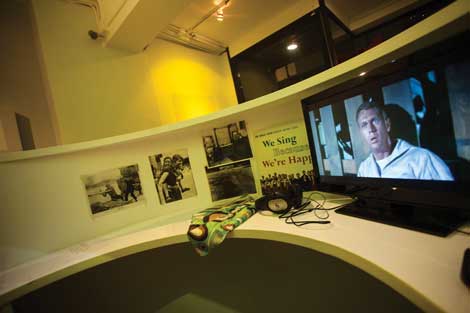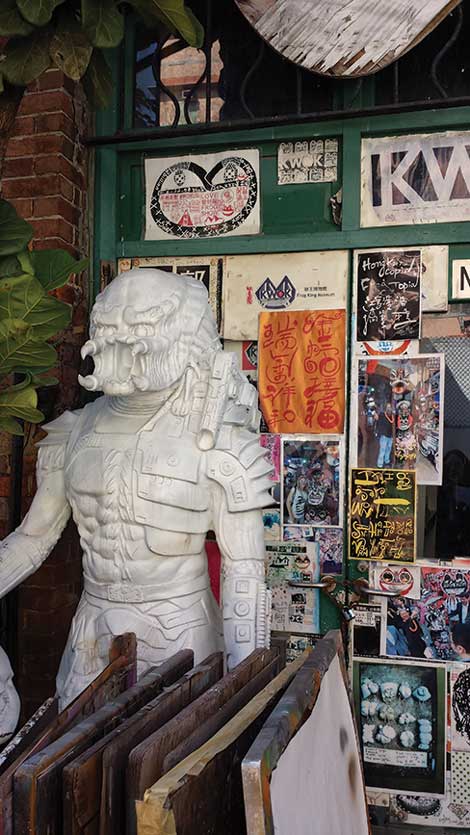Your cart is currently empty!
Field Report: Hong Kong

Once a city on the margins of the art world, Hong Kong now sits center stage, boasting the world’s third-largest art market. A wealth of galleries, museums and art centers can be found on either side of Victoria Harbor, which separates the commercial center, Hong Kong Island, from the Kowloon Peninsula, notable for its colorful open-air markets. Exploring the city’s diverse art offerings, I’m curious to learn how Hong Kong’s new global stature will be reflected in the local arts scene. I’m also immersed in the task of navigating Hong Kong, a labyrinthine city full of layers, both spatial and social. The maze of streets, walkways, paths, stairs and escalators is daunting. Luckily, the MTR subway system is user-friendly and efficient, with signs and announcements posted in English as well as Cantonese and Mandarin. This mix of languages reflects the nature of Hong Kong itself, which is a unique blend of influences and cultures, inclusion and exclusion.

Wan Chai
Divided into districts, Hong Kong Island includes the Wan Chai business section, home to the architecturally distinctive convention center, which, last fall, presented the first Basel Hong Kong art fair. Nearby, the Hong Kong Arts Centre, established in 1977, includes space dedicated to the visual and performing arts, classrooms, cinema, offices and the collective, Comix Home Base. The Centre’s 5th Annual Flagship Exhibition, “Distilling Senses: A Journey Through Art and Technology in Asian Contemporary Art,” showcases work exploring how technology informs art. It is here that I encounter an installation by teamLab. Set in a darkened room packed with large inflated orbs, Homogenizing and Transforming World (2013) requires the viewer to navigate the space by bumping into and pushing orbs out of the way. Each touch activates a color-changing mechanism in the individual orb, which then transmits a signal to all the others to change from blue to pink. This immersive and playful work examines the increasing unification of our global society as cultural differences become blurred in our haste to embrace the latest trends.
Also on view, Nam June Paik’s Charlie Chaplin (2001), an array of vintage televisions and high-tech monitors arranged in a robotic tower, addresses the over-mechanization of society in a cautionary tale of our humanity at risk. Samson Young’s installation from his “Liquid Borders” series (2012–present) combines graphical notations on paper with sounds collected from the vibrating wire fencing along the Hong Kong–China border, alluding to Hong Kong’s complex and shifting relationship with mainland China.

Central
Central District is home to many high-end galleries. These blue-chip venues are embedded among the glitzy department stores, malls and tourist sites. Within Central, the Pedder Building, located near the Victoria Peak tram station, is the main gallery hub. Here you’ll find PearlLam Gallery, a large, light-filled space where famous restaurateur Michael Chow, aka Zhou Yinghua, presented “Recipe for a Painter.” Returning to China after 50 years in the West, Chow addresses ideas of transition between cultures, meshing concerns of Abstract Expressionism, color field painting, traditional Chinese calligraphy and brush-and-ink painting—key issues in the evolution of art in Hong Kong.
Newcomers Lehmann Maupin and Gagosian—both opened spaces in Hong Kong in 2013—featured, respectively, Korean artist Do Ho Suh’s transparent soft sculptures and Frank Gehry’s glowing, large-scale suspended “Fish Lamps.” At Ben Brown Fine Arts, “Expression: A Philosophical Portrait of Humankind” selected by Martin Klosterfelde, included Ai Weiwei’s Fairytale (2007) incorporating Qing Dynasty chairs, while Simon Lee Gallery presented “Walk the Line,” a group show of abstract work. In conjunction with its 30-year anniversary, Hanart TZ, the oldest gallery in Hong Kong, is preparing exhibitions and a symposium on the state of art in China. Upscale and insular, White Cube and Galerie Perrotin share a building about 10 blocks away on Connaught Rd.

Sheung Wan
At the eastern terminus of the Hong Kong island metro line, Sheung Wan district houses alternative spaces and newer galleries. Para Site is showing “Great Crescent,” a politically charged show of 1960s anti-art performance-based work from Japan, South Korea and Taiwan. Yoko Ono’s iconic Cut Piece (1964) plays in the entryway. A video that includes period music like “In-A-Gadda-Da-Vida” documenting the collective Zero Dimension (Zero Jigen), which staged public, often naked, performances, imparts a strong acid-flashback vibe. In operation since 1996, artist-run Para Site is the oldest alternative arts center in Hong Kong. Since 1997, the disintegration of regional identity has emerged as a central concern to Hong Kong-based artists. By exhibiting the work of regional artists during the highly charged “reassimilation” period, Para Site has fostered the development of the Hong Kong scene in unique and important ways.
Run by George Michell, Studio Rouge on Hollywood Road features contemporary artists based in China. Farther up Hollywood Road, AP Contemporary is showing Korean artist Mari Kim’s “Famous Eyedoll.” Fun and engaging, Kim’s lenticular prints combine the look of wide-eyed anime characters with iconic female images from stage, screen and art history. Nearby Identity Gallery offers mixed media works by British artist Timothy Betjeman and Pop-inflected imagery by Kounosuke Kawakami from Japan.

Tsim Sha Tsui
Despite the rural ambiance suggested by its name, Cattle Depot Art Center is a short cab ride from West Kowloon’s Tsim Sha Tsui district. It is a protected historical site, and I’m a bit alarmed when I hear the guards will try to prevent my entry. I’ve been instructed to bluff my way in: “Just don’t make eye contact with them.” Built as an animal quarantine station on 1.7 hectares in 1908, The Ma Tau Kok Cattle Depot housed three livestock sheds and a large slaughterhouse. In 1999 it was transformed into an art venue. An attractive complex of red brick with green doors, it includes both artists’ studios and exhibition spaces. Videotage is a nonprofit space focusing on video and media art, while 1a Space facilitates community-based projects.
The Community Art Network coordinates socially conscious activities intertwined with aesthetic efforts. The Network regularly collects and distributes food for the poor, and it sponsored a project to create cardboard replicas of old buildings in Hong Kong. The models featured buildings with iconic balconies and distinctively patterned windows that are rapidly disappearing as the city evolves.
Of numerous additional venues I visit, Hong Kong Museum of Art, Osage Gallery and 10 Chancery Lane Gallery are some of the clear standouts. With the projected opening of the huge new M+ Hong Kong Arts Center in West Kowloon just around the corner in 2017, we may anticipate the emergence of a new major arts hub.

With the Chinese government displaying increasingly repressive tactics that infringe on freedom of speech, residents of historically independent-minded Hong Kong have now mobilized, jamming the streets with tens of thousands of students and pro-democracy protesters as I write. Much is at stake, as President Xi Jinping and the mainland government wish to prevent a successful protest in Hong Kong from inspiring similar uprisings on the mainland. What, indeed, will the future hold for Hong Kong’s freedom, political or artistic?
All uncredited photos by Barbara Morris